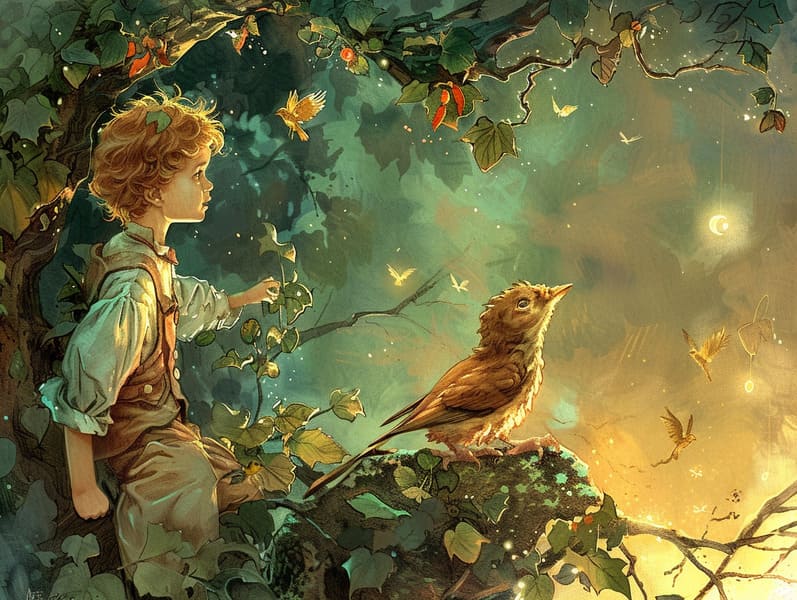The Birth of Fairy Tales for Kids with the Unending Majesty.

Famous fairy tales have historical significance. These stories have been recounted from one generation to the next well before they were ever put on paper. They developed from a variety of traditions, including American traditions. They were initially transmitted among elders, often carrying themes and messages relevant to the societal norms and beliefs of the time.
Jacob and Wilhelm Grimm, Jacob and Wilhelm (the Grimm brothers), were among the first to compile many of these beloved narratives. Their published works, "Grimm's Fairy Tales," included classics like "The Little Glass Slipper," "Hansel and Grethel," and "Snow-White and Rose-Red," which have since become pillars in the world of famous fairy tales. Similarly, the Danish author's whimsical tales, such as "The Sea Maid," and "The Little Duckling," have floated into hearts worldwide, solidifying their place in the pantheon of iconic fairy tales.
Though they are centuries old, these stories remain as significant as ever, especially as kids' bedtime tales. These magical stories are now available in various formats, including richly illustrated books, fantastical animations, and web-based fairy tales.
Their lasting presence can be linked to several enchanting factors:
Crucial Morals: Old fairy tales often provide important moral lessons. Fairy tales like "The Boy Who Cried Wolf" teach the virtue of truth, while "The Tortoise and the Hare" point out the qualities of determination and meekness. These narratives offer children clear distinctions between correct and incorrect, developing their moral compass in a subtle yet impactful way.
Empathy and Understanding: Traditional fairy tales frequently involve personalities facing challenges and problems, provoking audiences to comprehend with their struggles and champion their triumphs. For instance, "Beauty and the Beast" highlights the virtue of looking deeper to realize the real character of a soul, enhancing sympathy and perception.
Cultural Appreciation: Many classic fairy tales are infused with the cultural contexts from which they blossomed. Engaging with these narratives can provide informative snapshots into different customs, encouraging a sense of cultural understanding and awareness.
Creativity and Fantasy: The fantasy-filled elements in ancient fairy tales—mythical creatures—unleash children’s innovations. These stories carry readers to fantasy realms, triggering imaginative dreams and a sense of enchantment that stays a lifetime.
Classic fairy tales are not only fascinating but also educational. They function as charming tools in nurturing various brain and heart skills in kids. When fairy tales are told out loud, they develop verbal skills by teaching new terms and elaborate sentence structures. This practice also advances auditory skills and attention, as young ones remain attentive, eager to see what happens next.
Furthermore, exploring the themes and characters of timeless fairy tales can cultivate evaluative skills and problem-solving abilities. Little ones learn to discern patterns, expect results, and catch on to cause and effect. These examinations also encourage the young voice their thoughts and feelings, strengthening their emotional intelligence.
In today’s high-tech era, the presence of digital storybooks has made these stories more acquirable than ever. Websites and programs give extensive collections of traditional fairy tales that can be experienced or listened on anytime, anywhere. Fairy tales read out loud are particularly in demand, sharing an captivating way for children to immerse in these entrancing tales. Read-aloud stories find it here and voiced videos lead characters and settings to life, often augmented by mesmerizing melodies and harmonies that intensify the story journey.
The enduring charm of traditional fairy tales lies in their ability to evolve to the present while holding onto their fundamental ideas. Contemporary reinterpretations of these narratives often highlight more different protagonists and modern settings, making them understandable to today’s audience. However, the core values of heroism, humanity, and truth remain unchanged, continuing to reach young readers of all ages.
Old fairy tales also offer a sense of serenity and familiarity. They put forth a neat narrative with a clear beginning, middle, and end, often coming to a close with the finalization of conflicts and the triumph of honesty over deceit. This constancy can be easing for kids, rendering a sense of unwaveringness in an dynamic world.
Classic fairy tales continue to captivate and train new generations, maintaining their enchantment and relevance in modern society. As nighttime stories for kids, they yield a perfect blend of fantasy and learning, nurturing moral values, empathy, and creativity. The availability of digital fairy tales and the well-received status of fairy tales narrated promise that these classic stories remain attainable to new generations.
By upholding and relating these stories, we continue to recognize the rich tapestry of fantasy and cultural heritage. Whether you are accessing a artistically illustrated book, enjoying a online library, or listening via an voice book, the charm of traditional fairy tales is always within reach. These fairy tales demonstrate of the steadfast spell of narratives and its ability to unite us across generations and cultures.
Even if you are discovering a beautifully illustrated book, discovering a electronic library, or listening on an narrated book, the majesty of bedtime fairy tales is always within reach.
These tales point out of the lasting essence of stories and its ability to unite us across time and space, creating a bond that charms and informs alike.